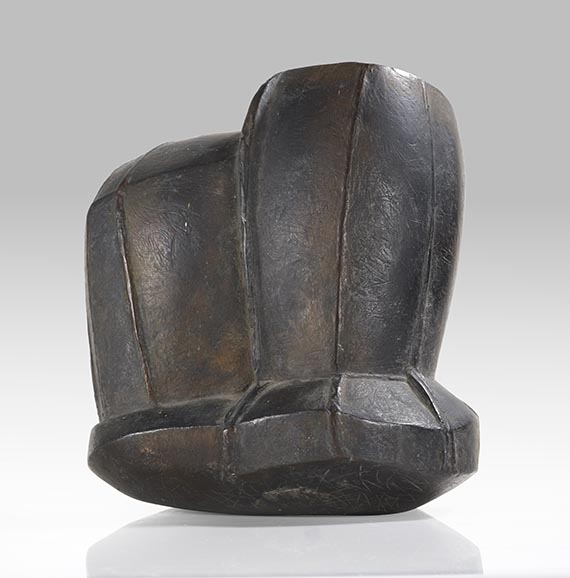Art (1945-contemporary) > Abstract Art Post-War Karl Hartung - Biography

Kopfstein V. Um 1960.
Bronze with brownish patina.
Markus Krause, Karl Hartung 1908-1967. Metamorphosen von Mensch und Natur (Metamorphoses of Man and Nature). Monograph and catalogue raisonné, Munich 1998, catalogue number 717 (illustrated on p. 144). With the foundry mark on the stamp. Height: 27 cm (10.6 in).
Cast by Barth, Berlin.
Ben Wargin (1930–2021), the former owner of the sculpture, was a student assistant to Karl Hartung. In 1962, Ben Wargin founded Galerie S, which initially focused on Berlin artists but later gained international recognition. [EH].
• Karl Hartung is a central figure in post-war German art.
• The Kopfsteine series represents an expansion of the artist's formal repertoire.
• Crystalline structures and subtly burred surfaces characterize this group of works.
• Block-like exploration of physical volume in enclosed space.
• Hartung creates a symbiosis of clear formal language and particularly sensual materiality.
PROVENANCE: From teh estate of Ben Wagin, Berlin.
EXHIBITION: Traveling exhibition of Berlin sculptors and painters. Galerie S. Ben Wargin, Berlin (West), etc. 1964–1965, cat. no. 23.
“In the late 1950s and 1960s, Hartung turned his attention to various groups of works, such as the so-called Kopfsteine (headstones) and Säulen-Plastiken (column sculptures), with which he expanded his repertoire of forms. […] The ‘Kopfsteine’ (headstones) are more representational in nature, although their name is misleading in that they have nothing in common with human or animal heads, nor was this a reference intended by Hartung. According to his daughter, Hartung was so enthusiastic about the ‘headstones’ of the cobblestones in front of his house during road works that he took some of these stones and let them inspire him (WV 655-657, 716-719; figs. 80, 81). However, when exhibiting the sculptures he had created, Hartung often refrained from giving them titles or called them ‘Prismatic’ or ‘Crystalline Form’ (WV 645 to 647, 715). The ‘head stones’ were created in the late 1950s, around the same time as the abstract stone sculptures. They are almost exclusively made of plaster for bronze, and their overall form results from the dense agglomeration of several sharp-edged or rounded elements, which are often furrowed or covered with ridges. These are always solid, fully sculptural structures without openings or cavities. With these works, Hartung returns – albeit in a greatly modified form – to voluminous, closed works that assert themselves as a sculptural core against the surrounding space without opening up to it in an interplay between interior and exterior. His aim here was both to visualize a certain sculptural principle and to artistically translate the natural model of crystalline forms. This equivalence is made clear not least by the material chosen. Even though the ‘headstones’ are reminiscent of bizarre rock formations, this impression is alienated by the dark bronze, which characterizes the sculptural form as an artistic form more strongly than in the abstract stone sculptures created at the same time. This expansion of motifs closes a circle: whereas Hartung's earlier, volume-emphasizing core sculptures referred exclusively to organic nature, he now transfers the same formal principle to inorganic nature" (Markus Krause, Werkverzeichnis zu Karl Hartung, Metamorphosen von Mensch und Natur, Munich 1998, p. 160 ff.).
For information concerning the condition, please view the high resolution image